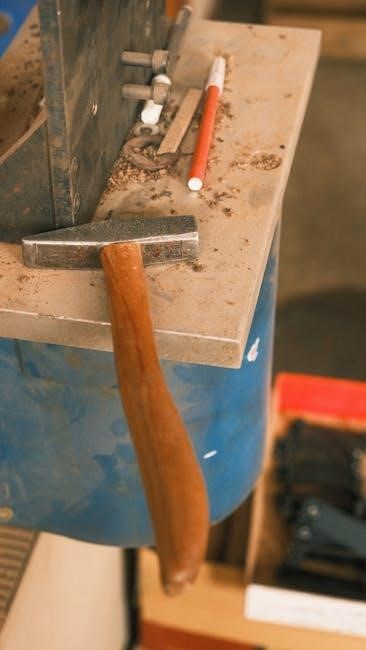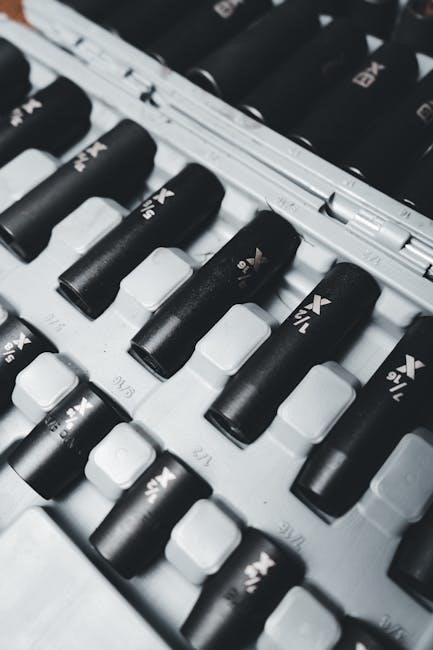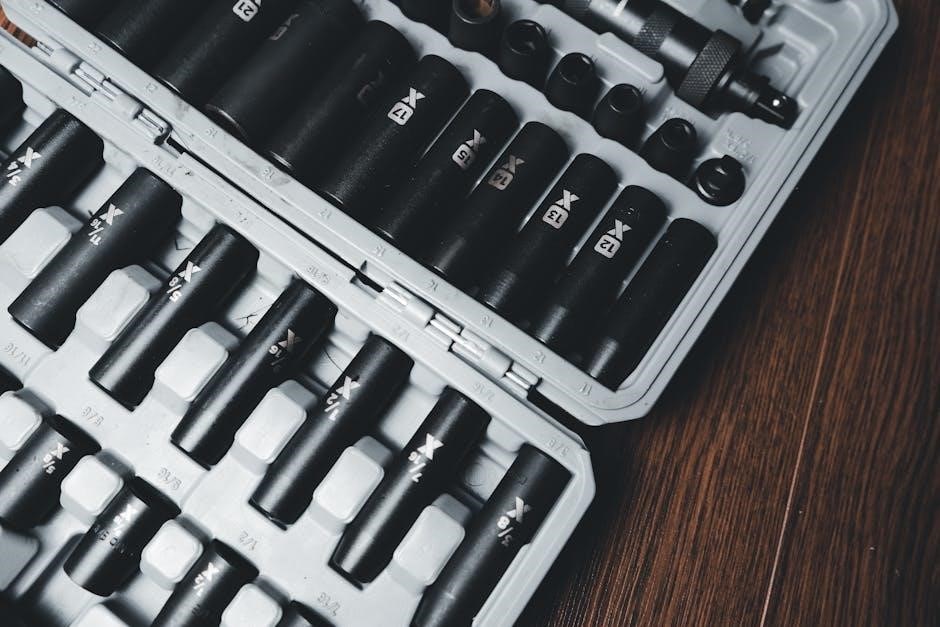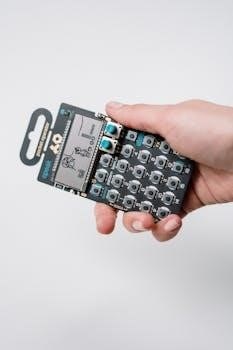Tru-Bolt Deadbolt Manual: A Comprehensive Guide
Welcome! This comprehensive guide serves as your ultimate resource for understanding and utilizing your Tru-Bolt deadbolt. From installation to troubleshooting, we cover everything you need to know for seamless operation and enhanced security, ensuring your peace of mind.

Tru-Bolt deadbolts offer homeowners, installers, and builders affordable, quality security solutions. These deadbolts, known for their robust construction and user-friendly designs, provide reliable protection for residential properties. Tru-Bolt offers both mechanical and electronic deadbolts, catering to various security preferences. Their product line includes classic digital deadbolts, electronic deadbolts with keypads, and even biometric models for advanced security.

This manual serves as your comprehensive guide to understanding, installing, and operating your Tru-Bolt deadbolt. Whether you’ve opted for a traditional keyed deadbolt or a cutting-edge electronic model, this guide provides step-by-step instructions and troubleshooting tips to ensure optimal performance.
With detailed explanations and helpful illustrations, this guide aims to empower you with the knowledge to maximize the security and convenience of your Tru-Bolt deadbolt. From understanding backset adjustments to programming user codes, we’ll cover essential aspects of your deadbolt’s functionality. We will also address common issues and provide effective solutions.
Tru-Bolt deadbolts provide enhanced security and peace of mind for your home.
Tru-Bolt Deadbolt Models and Variations
Tru-Bolt offers a diverse range of deadbolt models to suit various security needs and aesthetic preferences. Their product line includes classic mechanical deadbolts, electronic deadbolts with keypads, and advanced biometric deadbolts. Each model offers unique features and benefits.
The Classic series deadbolts provide traditional key-based security with robust construction and reliable performance. These models are available in various finishes to complement different door styles. Electronic deadbolts with keypads offer keyless entry convenience and enhanced security features, such as programmable user codes and temporary access codes.
For ultimate security and convenience, Tru-Bolt offers biometric deadbolts that utilize fingerprint recognition technology for secure and keyless access. These models provide a high level of protection against unauthorized entry.
Within each series, Tru-Bolt offers variations in design, finish, and functionality to meet specific customer requirements. Whether you prioritize simplicity, advanced technology, or a combination of both, Tru-Bolt has a deadbolt model to suit your needs.
Understanding the different models and variations available will help you choose the perfect deadbolt for your home’s security needs.
Adjusting the Deadbolt Latch Backset

The deadbolt latch backset is the distance between the edge of the door and the center of the bore hole where the deadbolt is installed. Tru-Bolt deadbolts typically have an adjustable latch backset to accommodate different door thicknesses and frame configurations.
The standard backset measurements are 2-3/8 inches (60mm) and 2-3/4 inches (70mm). To adjust the backset, you’ll usually need to rotate or slide the latch mechanism on the back of the deadbolt assembly. Refer to your Tru-Bolt deadbolt manual for specific instructions on how to adjust the backset for your particular model.
Before making any adjustments, ensure the deadbolt latch is retracted and the key is removed for safety. Use a screwdriver to loosen any screws securing the latch mechanism, and then carefully adjust the backset to the desired measurement.
Once the backset is adjusted, tighten the screws to secure the latch mechanism in place. It’s crucial to ensure the backset is properly adjusted to ensure smooth operation of the deadbolt and proper alignment with the strike plate on the door frame.
If the backset is not adjusted correctly, the deadbolt may not fully extend or retract, compromising the security of your door.
Programming Tru-Bolt Electronic Deadbolts
Programming your Tru-Bolt electronic deadbolt involves setting up user codes and configuring settings to customize its operation. The programming process varies depending on the specific model, but generally involves using the keypad and following a set of instructions outlined in the user manual.
Before you begin, ensure that the batteries are fresh and properly installed. It’s also recommended to keep the door unlocked during the programming process to avoid being locked out accidentally.
Start by locating the programming instructions in your Tru-Bolt deadbolt manual. Typically, you’ll need to enter a default master code or press a specific button to enter programming mode. From there, you can add new user codes, delete existing codes, and change other settings such as auto-lock duration and volume.
When adding user codes, choose a combination of numbers that is easy for you to remember but difficult for others to guess. Avoid using common codes like “1234” or your birth year.
After entering each code, be sure to test it to ensure it works correctly. If you encounter any issues during the programming process, refer to the troubleshooting section of your Tru-Bolt deadbolt manual or contact customer support for assistance.
Using the Default Master Code

The default master code is a pre-set code programmed into your Tru-Bolt electronic deadbolt at the factory. This code is essential for initial setup, programming new user codes, and managing the lock’s settings. Typically, the default master code is “123456,” but it’s crucial to consult your specific model’s manual to confirm the correct code.
Upon receiving your new Tru-Bolt deadbolt, the first step should always be to change the default master code to a unique and secure code known only to you. This is a critical security measure to prevent unauthorized access and maintain control over your lock.
To change the default master code, refer to the programming instructions in your user manual. The process usually involves entering the default master code, followed by a specific sequence of buttons to initiate the code change. You’ll then be prompted to enter your new master code, which should be a combination of numbers that is easy for you to remember but difficult for others to guess;

After changing the master code, test it thoroughly to ensure it works correctly. Store the new master code in a safe and secure location, away from the lock itself. Avoid sharing the master code with anyone who doesn’t need it.
Troubleshooting Common Problems
Even with proper installation and usage, you might encounter occasional issues with your Tru-Bolt deadbolt. One common problem is the deadbolt not extending or retracting smoothly. This could be due to misalignment between the latch and strike plate. Ensure the strike plate is properly aligned and the door closes fully. If necessary, adjust the strike plate’s position or tighten its screws.
Another frequent issue is a non-responsive keypad. First, check the batteries and replace them if they’re low. If the keypad still doesn’t work, try resetting the lock by removing the batteries for a few minutes and then reinserting them. If this fails, consult your manual for specific troubleshooting steps related to keypad issues.
Sometimes, the deadbolt might not lock or unlock after a battery change. This could be due to incorrect battery installation or a temporary system glitch. Double-check that the batteries are inserted correctly, matching the polarity markings. If the problem persists, try reprogramming the lock or resetting it to factory settings.
If you encounter any other problems, such as error codes or unusual noises, refer to your Tru-Bolt deadbolt’s user manual for detailed troubleshooting information. The manual provides specific solutions for various issues, helping you diagnose and resolve the problem efficiently.
Tru-Bolt Deadbolt Not Working After Battery Change
A common frustration with electronic deadbolts is when they cease functioning after a battery replacement. With Tru-Bolt deadbolts, this issue often stems from a few key causes. First, ensure the new batteries are fresh and of the correct type, typically AA or AAA alkaline batteries, as specified in your user manual. Inserting batteries with insufficient charge will prevent the lock from operating correctly.
Next, verify the batteries are installed with the correct polarity. Mismatched polarity can disrupt the circuit and prevent the lock from powering on. Refer to the markings inside the battery compartment for proper alignment.
Sometimes, the lock’s system may experience a temporary glitch after a battery change. To resolve this, try performing a system reset. Remove the batteries for approximately five to ten minutes, then reinsert them. This can often clear any residual charge or corrupted data.
If the deadbolt still doesn’t work, the lock may require reprogramming. Consult your Tru-Bolt manual for instructions on resetting the master code or user codes. Reprogramming can restore the lock’s functionality and ensure it responds to the correct inputs. If all else fails, contact Tru-Bolt customer support for further assistance.
Keypad Issues and Solutions
Tru-Bolt electronic deadbolts, while convenient, can sometimes present keypad-related challenges. A common issue is unresponsiveness, where the keypad fails to illuminate or register key presses. This often stems from depleted batteries, so replacing them is the first step. If new batteries don’t resolve the problem, check for corrosion on the battery terminals, cleaning them gently with a dry cloth.
Another frequent concern is incorrect code entry. Ensure you’re entering the correct user code, and that the keypad is clean and dry, as moisture or debris can interfere with button presses. If you’ve forgotten the code, consult your Tru-Bolt manual for instructions on resetting to the default master code, which is often “123456,” but always verify.
Keypad jamming or sticking buttons can also occur. Try gently cleaning around the buttons with a soft brush or compressed air to remove any obstructions. If buttons remain unresponsive, the keypad itself may be faulty, requiring replacement.
In some cases, the keypad may beep continuously or display error codes. Refer to your Tru-Bolt manual for specific error code meanings and troubleshooting steps. A system reset, involving battery removal and reinstallation, can sometimes resolve these issues. If problems persist, contacting Tru-Bolt customer support is recommended for expert assistance.
Warranty Information for Tru-Bolt Products
Tru-Bolt provides warranties to ensure customer satisfaction and product reliability. Typically, Tru-Bolt electronic deadbolts come with a 1-year limited warranty covering electronic parts against defects in materials and workmanship. This warranty ensures that if any electronic component malfunctions during the warranty period under normal use, Tru-Bolt will repair or replace it.

Additionally, Tru-Bolt often offers a limited lifetime mechanical and finish warranty. This warranty covers mechanical failures and defects in the finish of the deadbolt under normal residential use. It guarantees that the deadbolt’s mechanical components will function properly and the finish will remain free from defects like peeling or corrosion for the lifetime of the product, as long as it’s owned by the original residential user.
To make a warranty claim, it’s usually necessary to provide proof of purchase, such as a receipt, and follow Tru-Bolt’s specific procedures outlined in the product manual or on their website. The warranty may not cover damages resulting from improper installation, misuse, abuse, or unauthorized modifications. Always consult the complete warranty documentation for detailed terms and conditions, including any exclusions or limitations that may apply. Proper maintenance and adherence to installation guidelines are essential for maintaining warranty coverage.
Installation Instructions for Tru-Bolt Deadbolts
Installing a Tru-Bolt deadbolt typically involves a series of straightforward steps to ensure proper functionality and security. Begin by gathering the necessary tools, including a screwdriver, measuring tape, and possibly a drill. First, prepare the door by marking the center of the deadbolt location using the provided template. Drill the appropriate-sized holes for the deadbolt and latch according to the template’s specifications.

Next, insert the deadbolt latch into the edge of the door, ensuring it aligns correctly with the marked center. Secure the latch with screws. Then, install the exterior faceplate, threading the control wires through the designated hole. Attach the interior faceplate, connecting the control wires and securing it with screws. Ensure both faceplates are aligned and flush against the door surface.
Afterward, prepare the doorframe by installing the strike plate. Align the strike plate with the deadbolt latch and secure it with screws. Test the lock by extending and retracting the deadbolt using the interior knob and exterior keypad, if applicable. Ensure smooth operation and proper alignment. Finally, program the deadbolt according to the manufacturer’s instructions, setting up user codes and master codes as needed. Always refer to the specific installation manual for your Tru-Bolt model for detailed instructions and safety precautions.
Locking and Unlocking Procedures
Understanding the locking and unlocking procedures for your Tru-Bolt deadbolt is crucial for secure and convenient operation. Generally, locking the deadbolt can be achieved through several methods, depending on the model. For manual deadbolts, simply turn the interior thumb turn to extend the bolt into the strike plate on the door frame. Ensure the bolt is fully extended to provide maximum security.
Electronic deadbolts offer multiple locking options. You can typically lock the door by pressing a designated button on the keypad, often accompanied by a beep or visual confirmation. Some models may automatically lock after a set period of inactivity; To unlock the Tru-Bolt deadbolt from the inside, use the thumb turn to retract the bolt.

From the outside, electronic deadbolts can be unlocked using a valid user code. Enter the code on the keypad, followed by a designated button, such as a checkmark or lock symbol. Upon successful entry, the deadbolt will retract, allowing you to open the door. In case of a forgotten code or electronic malfunction, a physical key override is usually provided. Insert the key into the keyhole and turn to manually unlock the deadbolt. Always ensure you have easy access to the key in case of emergencies.

Operating the Deadbolt with the Keypad
The keypad on your Tru-Bolt electronic deadbolt provides a convenient and keyless way to control access to your home. To operate the deadbolt using the keypad, begin by ensuring the keypad is active. Some models require a touch to illuminate the keypad, while others are always on. Once the keypad is ready, enter your programmed user code.
The default master code is often “123456,” but it’s highly recommended to change this for security purposes. After entering the user code, press the designated lock or unlock button. This button may be represented by a lock symbol, a checkmark, or another icon, as indicated in your user manual. Upon successful code entry and button press, you should hear a confirmation beep and see a visual indication, such as a green light, signaling that the deadbolt has been activated.
To lock the door, simply press the lock button on the keypad. The deadbolt will extend, securing the door. To unlock, enter your user code followed by the unlock button. The deadbolt will retract, allowing you to open the door. If the code is entered incorrectly, the keypad will typically display an error message or emit a different sound. Refer to your manual for specific troubleshooting steps if you encounter any issues. Remember to keep your keypad clean and free from debris for optimal performance.
Manual Override and Key Usage
Your Tru-Bolt deadbolt is equipped with a manual override feature, providing a traditional key-based access method in case of electronic malfunction or battery failure. The keyhole is typically located on the exterior side of the deadbolt, often concealed by a cover or integrated into the keypad design. To use the manual override, simply insert the provided key into the keyhole and turn it in the appropriate direction to lock or unlock the deadbolt.
It’s crucial to keep your key in a safe and easily accessible location, but not in close proximity to the door itself. Consider giving a spare key to a trusted neighbor or family member for emergencies. Regularly test the key to ensure it functions smoothly within the lock cylinder. If the key becomes difficult to turn or gets stuck, apply a small amount of lubricant specifically designed for locks.
Avoid using excessive force, as this could damage the key or the lock mechanism. The manual override feature provides a reliable backup system, ensuring you can always access your home, even when the electronic components are not functioning; Familiarize yourself with the key’s operation to be prepared for any unforeseen circumstances. Remember to consult your user manual for specific instructions and diagrams related to your Tru-Bolt deadbolt model.



